
The Informatics Forum is a major building on the Central Area campus of the University of Edinburgh. Completed in 2008, it houses the research institutes of the University's School of Informatics.

The Informatics Forum is a major building on the Central Area campus of the University of Edinburgh. Completed in 2008, it houses the research institutes of the University's School of Informatics.
The Forum is designed by Bennetts Associates [1] with Reiach and Hall, architects, and Buro Happold, engineers. The architects' brief was to provide a "forum for interaction" that will foster synergies among the 500 researchers in Informatics: Artificial Intelligence, Cognitive Science, Computer Science, and Systems Biology, who have been brought together, under one roof, by this development.
The building was the first in Scotland to achieve a BREEAM rating of "excellent", [2] and was constructed by Balfour Beatty. [3]
One of the major recommendations of the 1997 international review that led to the formation of Informatics as an academic grouping at Edinburgh, was that the University should provide a building for the collocation of Informatics. [4] An options appraisal recommended that the University should plan for the collocation of Informatics in a new construction within the University's George Square Campus, using the long-vacant Crichton Street site.
In 2002, the University embarked on a fund-raising campaign. This was followed closely by the Edinburgh Cowgate Fire of December 2002, [5] which destroyed a number of buildings, including some of the School's accommodation at 80 South Bridge. [6] The School took over four floors of the Appleton Tower as emergency accommodation. [7] In the following years, plans for the School's accommodation were revised to include six floors of the Appleton Tower, and a new building on the Crichton Street Site.
In all, £42M was raised from public and philanthropic sources. [8] Planning approval was confirmed on 12 September 2005, and work on site commenced in October 2005. The Informatics Forum was opened by then First Minister Alex Salmond in September 2008. [3] [4]
The Forum is the first phase of the Potterrow Project, the redevelopment of a site, bordered by Potterrow, Crichton Street, Charles Street and Marshall Street, that was cleared for redevelopment by the University in 1963, and has been used as a car park ever since. The Potterrow Project is itself part of a more extensive masterplan, that will see the Potterrow underpass removed and the campus extended to link Old College to George Square. [9]
The Informatics Forum, as part of the wider Potterrow development, was joint winner of the RIAS Andrew Doolan Best Building in Scotland Award in 2008. [1] [10]

George Square is the principal civic square in the city of Glasgow, Scotland. It is one of six squares in the city centre, the others being Cathedral Square, St Andrew's Square, St Enoch Square, Royal Exchange Square, and Blythswood Square on Blythswood Hill.

Heriot-Watt University is a public research university based in Edinburgh, Scotland. It was established in 1821 as the School of Arts of Edinburgh, the world's first mechanics' institute, and subsequently granted university status by royal charter in 1966. It is the eighth oldest higher education institute in the UK. The name Heriot-Watt was taken from Scottish inventor James Watt and Scottish philanthropist and goldsmith George Heriot.

The School of Informatics is an academic unit of the University of Edinburgh, in Scotland, responsible for research, teaching, outreach and commercialisation in informatics. It was created in 1998 from the former Department of Artificial Intelligence, the Centre for Cognitive Science and the Department of Computer Science, along with the Artificial Intelligence Applications Institute (AIAI) and the Human Communication Research Centre.
Richard Murphy OBE is a British architect and businessman. He is the founder and principal architect of Richard Murphy Architects, an architectural firm operating in Edinburgh. He is winner of the 2016 RIBA House of the year.

The Big City Plan is a major development plan for the city centre of Birmingham, England.
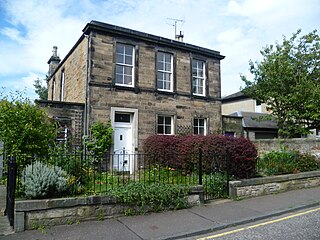
Sciennes is a district of Edinburgh, Scotland, situated approximately 2 kilometres south of the city centre. It is a mainly residential district, although it is also well-known as the site of the former Royal Hospital for Sick Children. Most of its housing stock consists of terraces of four-storey Victorian tenements. The district is popular with students, thanks to its proximity to the University of Edinburgh. Its early history is linked to the presence in the area of the 16th-century Convent of St Catherine of Scienna, from which the district derives its name.

Appleton Tower is a tower block in Edinburgh, Scotland, owned by the University of Edinburgh.
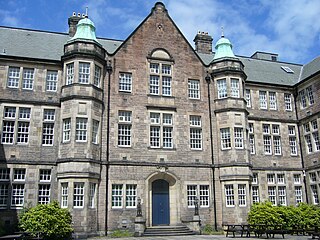
The Moray House School of Education and Sport is a school within the College of Arts, Humanities and Social Science at the University of Edinburgh. It is based in historic buildings on the Holyrood Campus, located between the Canongate and Holyrood Road.

The King's Buildings is a campus of the University of Edinburgh in Scotland. Located in the suburb of Blackford, the site contains most of the schools within the College of Science and Engineering, excepting only the School of Informatics and part of the School of Geosciences, which are located at the central George Square campus. The campus lies south of West Mains Road, west of Mayfield Road and east of Blackford Hill, about 2 miles (3.2 km) south of George Square. Scotland's Rural College (SRUC) and Biomathematics and Statistics Scotland (BioSS) also have facilities there.
The Edinburgh Stanford Link is a £6 million, 5 year initiative funded by Scottish Enterprise to foster collaborative research and commercialisation links between the Human Communication Research Centre at the University of Edinburgh and the Center for the Study of Language and Information at Stanford University. Starting in Feb 2002, the programme focuses on speech and language processing technology. There are two core parts to the Link, the commercial programme and the student programme. The former focuses on working with commercial companies and the latter focuses on fostering a culture of entrepreneurship within the University of Edinburgh. They are located in Level 8 in Appleton Tower, Crichton Street, Edinburgh.
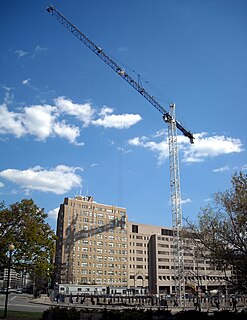
Square 54 Redevelopment is a complex of high-rise buildings located on the main campus of The George Washington University (GW) in Washington, D.C., United States. The new GW complex is mixed-use, with residential and office buildings and ground-level retail space along Eye Street to serve the campus and neighborhood. The complex will be completed with three buildings, Square 54 Residential I, Square 54 Residential II, and Square 54 Office. Square 54 Residential I is expected to rise 157 feet (48 m), featuring 14 floors. Square 54 Residential II is expected to rise 144 feet (44 m), featuring 12 floors. Finally, Square 54 Office, is expected to rise 148 feet (45 m), featuring 11 floors. Construction of every building will be completed in 2011. Each building will be designed by the architect, Pelli Clarke Pelli Architects and Hickok Cole Architects. The complex will replace the former George Washington University Hospital building, which was razed to make way for the construction of the Square 54 Complex.

Robert Reid was the King's architect and surveyor for Scotland from 1827 to 1839. He is responsible for a number of public works particularly the façade of Parliament Square in Edinburgh, which houses the Court of Session. Stylistically he was heavily influenced by Robert Adam, but Reid's style is more austere. The style is now seen as the main character of the northern Edinburgh New Town and without Reid Edinburgh would today be a very different city.
All types of architectural projects in Scotland are eligible, including new-build, regeneration, restoration, extensions and interiors.

The Potterrow Mandela Centre or Potterrow Student Centre is a students' union building in Edinburgh, Scotland.
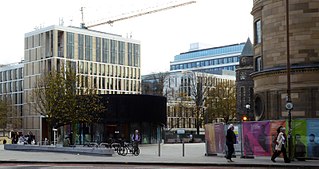
Bristo Square, Edinburgh, Scotland, is a public space on the estate of the University of Edinburgh. It lies in the south of the city, between George IV Bridge and George Square.
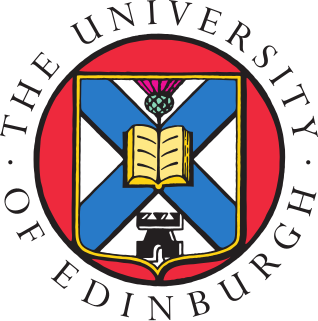
The University of Edinburgh is a public research university in Edinburgh, Scotland. Granted a royal charter by King James VI in 1582 and officially opened in 1583, it is one of Scotland's four ancient universities and the sixth-oldest university in continuous operation in the English-speaking world. The university played an important role in Edinburgh becoming a chief intellectual centre during the Scottish Enlightenment and contributed to the city being nicknamed the "Athens of the North".
Morris and Steedman was an architecture firm based in Edinburgh, Scotland. The firm was founded by James Shepherd Morris (1931–2006) and Robert Russell Steedman in the 1950s. The pair are best known for their private houses in the modernist style, built during the 1950s and 1960s, described as "arguably the most important series of 20th century houses by a single practice in Scotland". Both founders retired in 2002, although their practice continues as Morris and Steedman Associates.
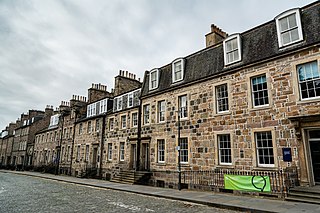
George Square is a city square in Edinburgh, Scotland. It is in the south of the city centre, adjacent to the Meadows. It was laid out in 1766 outside the overcrowded Old Town, and was a popular residential area for Edinburgh's better-off citizens. In the 1960s, much of the square was redeveloped by the University of Edinburgh, although the Cockburn Association and the Georgian Group of Edinburgh protested. Most but not all buildings on the square now belong to the university. Principal buildings include the Gordon Aikman Lecture Theatre, Edinburgh University Library, 40 George Square and Appleton Tower.
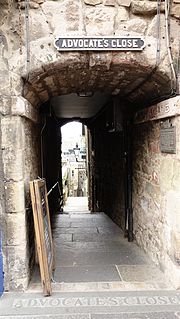
Advocates Close is a narrow and steep alley in Edinburgh of medieval origin, redeveloped in the early 21st century. With a multiplicity of steps it is not accessible to disabled persons.

40 George Square is a tower block in Edinburgh, Scotland forming part of the University of Edinburgh. Until September 2020 the tower was named David Hume Tower. The building contains lecture theatres, teaching spaces, offices, a café and a shop.
| Wikimedia Commons has media related to Informatics Forum . |
Coordinates: 55°56′41″N3°11′14.5″W / 55.94472°N 3.187361°W